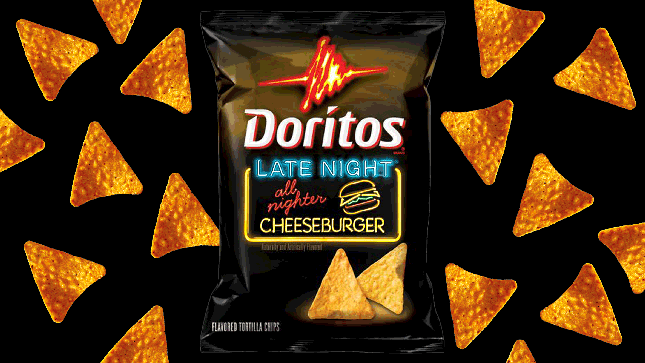Inside the Desperate, Dedicated World of Discontinued Snack Obsessives
In Facebook groups and online campaigns, fans fight for the return of their favorite discontinued snacks
In DepthIn Depth
Gif: Elena Scotti (Photos: Amazon, Shutterstock)
Nearly a decade ago, I ate the perfect chip: a Dorito designed to taste like a cheeseburger.
The flavor printed on the bag in the bright font of neon signage was “Late Night, All Nighter, Cheeseburger,” as if the Doritos brand couldn’t decide if the diner burger you were supposed to be eating in chip form was a meal appropriate for 10 p.m. or 3 a.m. The chip was dusted in a slightly spicy, nutty cheese blend that gave way to a smokier, somewhat beefier flavor. As I munched, letting the dust of fake spices settle on my tongue, another extremely distinct taste wiggled into the whole experience: a bright, sour pickle, as clear as if I had eaten one out of a jar. Later I learned that the chip’s flavor was due to a mixture of beef stock, mustard seed, and onion powder (though none of that explains the phantom ghost pickle residue).
It was 2011, and just as soon as I was standing in my childhood home lazily eating Late Night, All Nighter Cheeseburger Doritos, an impulse purchase from a recent suburban grocery haul, they seemed to disappear. The Frankenstein’d chips were discontinued sometime in the 2010s, a relic of a one-off experiment from Frito-Lay, and my sporadic Googling to acquire more bags in the past decade always turned up cold. (Doritos, FritoLay, and a number of people from the brand’s research and development teams did not respond to my pestering emails asking them to enlighten me on how new Doritos flavors get designed and retired.) But the cheeseburger chips, enthusiastically reviewed by early snack bloggers, attracted a cult fan base, united not just in their push to bring the chips back but also in their current misery.
There are Facebook pages calling on the company to Bring Back Cheeseburger Doritos, and at one point there was even a Change.org petition. “My roommate rolls her eyes every time someone offers me Doritos because I’ve boycotted them ever since they got rid of the cheeseburger flavor,” one commenter wrote on Facebook. “Please bring them back. I can’t do another decade without them,” another pleaded. “If they have braught [sic] back Crystal Pepsi, why not this?” read the now-shuttered Change.org petition, which racked up a measly 132 supporters. In an era when big corporations are so eager to drum up brand loyalty that they’ll actually pretend to be individuals on social media, people have seized on that reality to lobby for the most frivolous requests, knowing that if they make enough noise on social media, a brand will have to take notice.
In 2016 Crystal Pepsi, the clear version of the namesake drink that debuted in the 1990s, returned to the market for a limited time, and then again for a limited promotion in 2017, largely due to an aggressive online campaign that rallied around its return. A Change.org petition accumulated over 38,000 signatures; there was a hashtag spam campaign on Pepsi social media posts and even a series of billboards asking for the drink back around Los Angeles, all spearheaded by Youtuber and competitive eater Kevin Strahle. “We all have a passion, and we just want to see Crystal Pepsi come back and share the joy, that’s all,” he told ABC News at the time. Pepsi relented.
Nostalgia for discontinued and niche snacks has led to a burgeoning online re-selling market, where people pining for old Dunkaroos or their favorite, long-lost cereal from their childhood can buy them (usually expired) from a variety of specialty sites. But some aren’t content to scour Ebay and, if they’re lucky, grab a few bags of their retired snack of choice. Some hold out hope their chosen snack food will be revived, manufactured for the masses and back on the shelves if even for a moment.
-

-

-

-

-

-

-

-

-

-

-

-

-

-

-

-

-

-

-

-

-

-

-

-

-

-

-

-

-

-

-

-

-

-

-

-

-

-

-

-








































